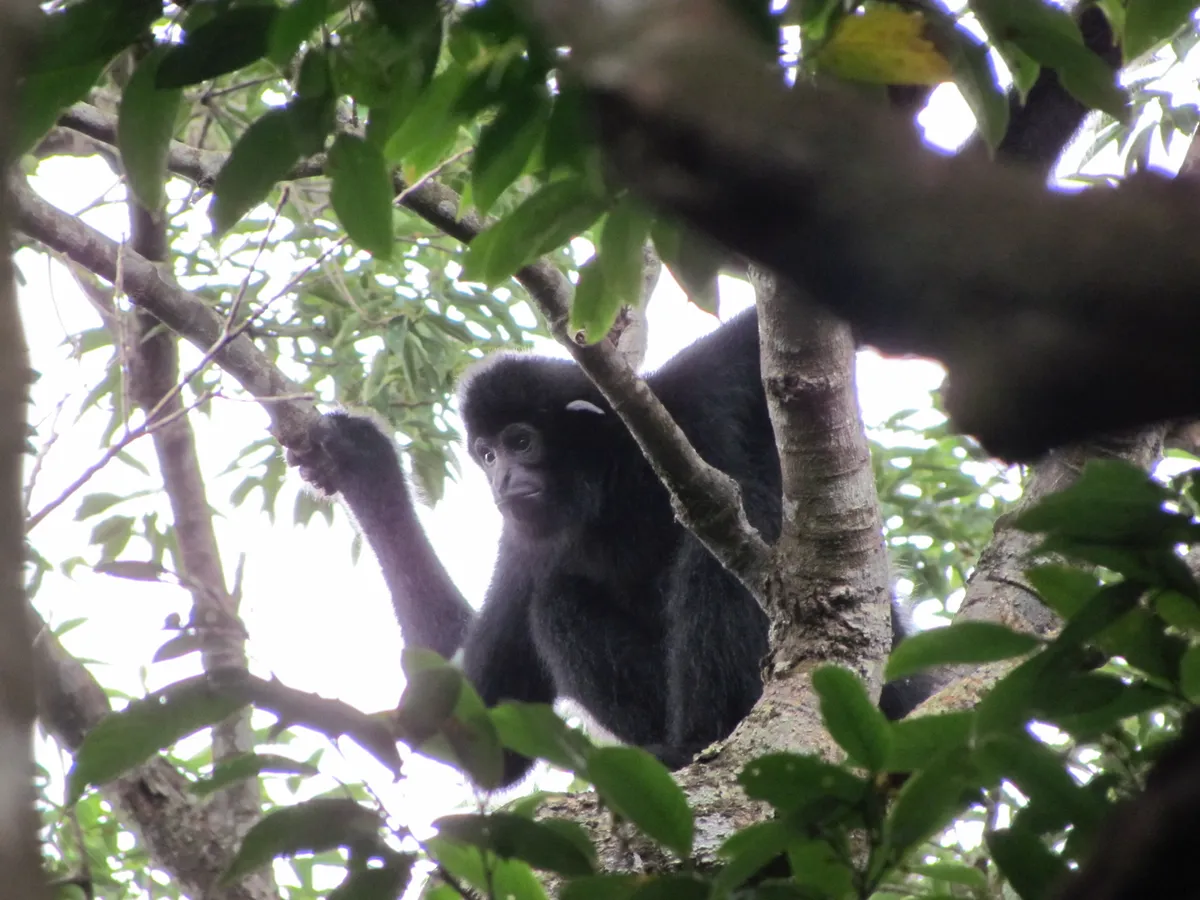What is the scientific name of the Hainan gibbon?
The scientific name of the Hainan gibbon is Nomascus hainanus.
Where do Hainan gibbons live?
Hainan gibbons are endemic to China, meaning they are not found anywhere else. The entire population of about 28 individuals are located in a 15 km2 fragment of suboptimal forest in Bawangling National Nature Reserve on Hainan Island in the South China Sea.
Are Hainan gibbons apes or monkeys?
All 20 species of gibbons, including the Hainan gibbon, are classified as apes. Unlike most monkeys, apes do not have tails.
Gibbons are referred to as small apes along with their siamang cousins. The great apes are better known in comparison and include the orangutan, chimpanzee, bonobo and gorilla. Apes are human’s closest living relatives. In fact, we shared a common ancestor with gibbons as recently as 16.8 million years ago!
Do Hainan gibbons live in groups?
A group of gibbons is known as a family, which is normally made up of 3-4 individuals. The majority of gibbon species are monogamous: a male and female will pair and mate for life and have offspring every 2-4 years. When the offspring reaches maturity at 7-8 years of age, it will likely disperse to find a mate of its own. Monogamy is rare and is only seen in 5% of all mammals.
Hainan gibbons are polygynous, however. This means the family is made up of a male and two or more breeding females. The largest Hainan gibbon family ever recorded had 11 individuals! The reasons for polygyny are still not fully understood in this species, but the small population, lack of new mates and limited habitat space could provide an explanation for this social system.

Where do Hainan gibbons sleep?
Gibbons are arboreal, meaning they live exclusively in the trees. Unlike other ape species, gibbons do not make nests to sleep in. Instead, gibbons carefully choose sleeping trees that are large with strong, horizontal branches.
Here they sleep in an upright position by tucking their knees up to their chests and wrapping their long arms around their bodies. To avoid sores, gibbons have evolved hard “seat pads” called ischial callosities on their buttocks.
What do Hainan gibbons eat?
Hainan gibbons are largely frugivorous (eat fruit) and folivorous (eat leaves), but gibbons are also known to like snacking on insects, flowers and bird eggs.
How fast is a Hainan gibbon?
Gibbons are the true king of the swingers and highly adapted to life in the trees. Their hands are like ‘hooks’, which enables them to suspend and hang for extended periods of time.
They also have long arms that they use to swing from branch to branch, a unique form of locomotion known as brachiation. They are extremely quick and can reach speeds of 55 km/h (34 mph), clearing distances of up to 12 m with one swing!
How do Hainan gibbons communicate?
Gibbons are the Adele of the animal world! All 20 species are famous for their haunting species-specific songs that they use to communicate with other gibbons.
Gibbons often sing first thing in the morning to maintain territorial boundaries, advertise to potential mates and enhance family bonds.
Are Hainan gibbons at risk of extinction?
In the 1950s, more than 2000 individuals were estimated to remain throughout the island of Hainan. Sadly, Hainan gibbon numbers plummeted in the second half of the 20th Century.
The reasons for this decline are largely due to deforestation and resultant habitat loss to cater for an ever-expanding human population, and hunting for food and traditional Chinese medicine.

Is it possible to see Hainan gibbons in the wild?
Due to their small population size and heightened restrictions, it is not possible to see Hainan gibbons in the wild. It is possible however to visit Bawangling National Nature Reserve where the gibbons are found, which is a popular site for birdwatchers and hiking enthusiasts.
What is being done to protect Hainan gibbons?
There are a few national and international groups working to save the Hainan gibbon. Through collaborations with Hainan University, Cloud Mountain Conservation, Arcus Foundation, International Union for Conservation of Nature, ZSL (Zoological Society of London) is working hard to secure a future for this Critically Endangered species.
Conservation research activities include the exploration of new monitoring technologies, investigating the possible survival of other remnant populations, and developing “win-win” solutions for gibbon conservation and human well-being by working closely with local communities to understand perceptions of biodiversity loss and livelihood needs.
Carolyn Thompson is a Swiss-British primatologist with 15 years’ worth of experience in this field. She holds a Masters in Research in Primate Biology, Behaviour and Conservation, and is currently a PhD researcher at University College London and ZSL’s Institute of Zoology.
Her research uses a mixed-method, interdisciplinary approach to examine the human-gibbon interface in China, Vietnam and Myanmar to understand patterns and drivers of small ape decline. She is focusing on the world's rarest gibbon, the Hainan gibbon, Nomascus hainanus, as well as the Cao Vit gibbon, Nomascus nasutus, and the newly discovered Skywalker Hoolock gibbon, Hoolock tianxing.
Main image: Hainan gibbon female with infant. © Jessica Bryant/ZSL
